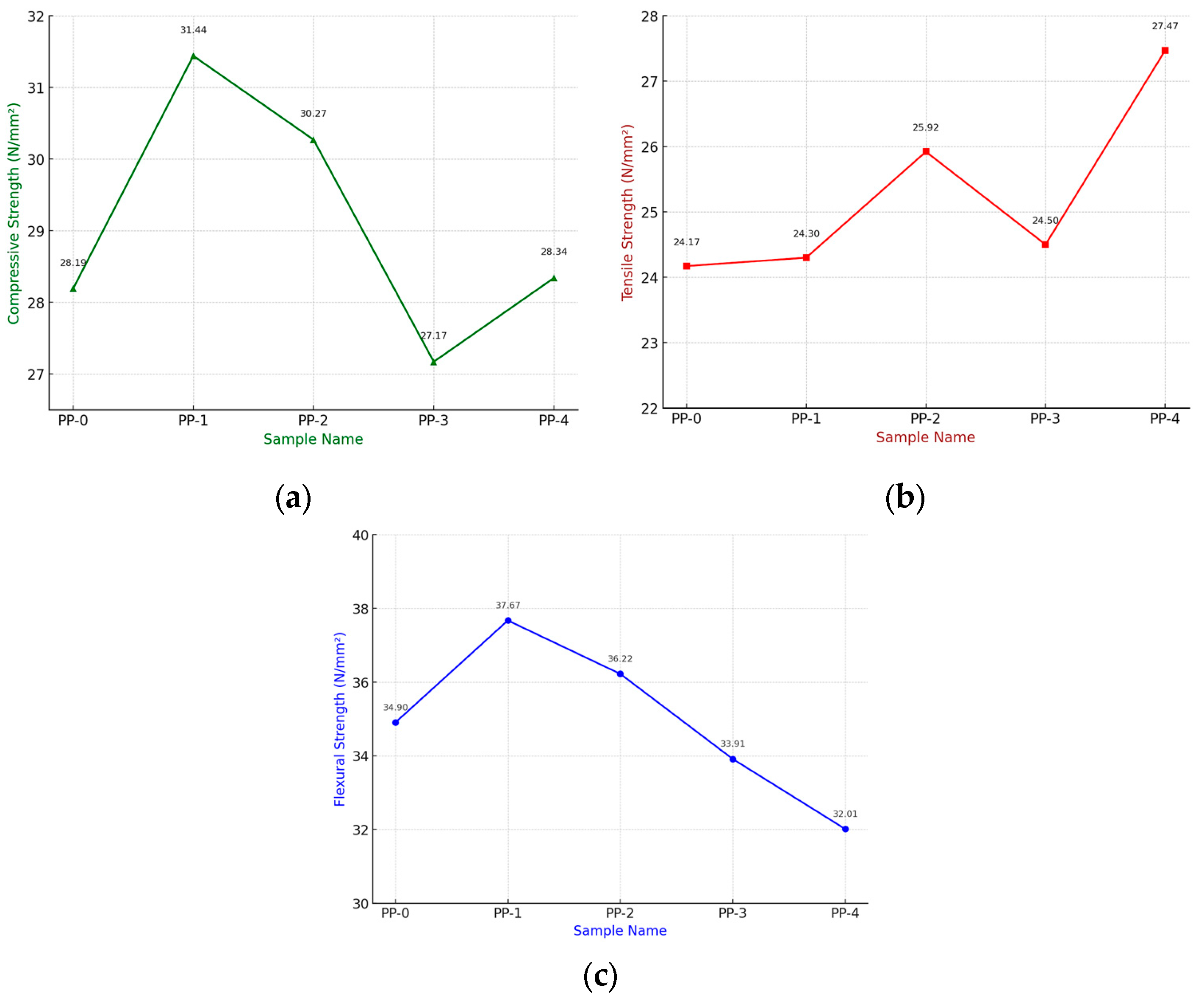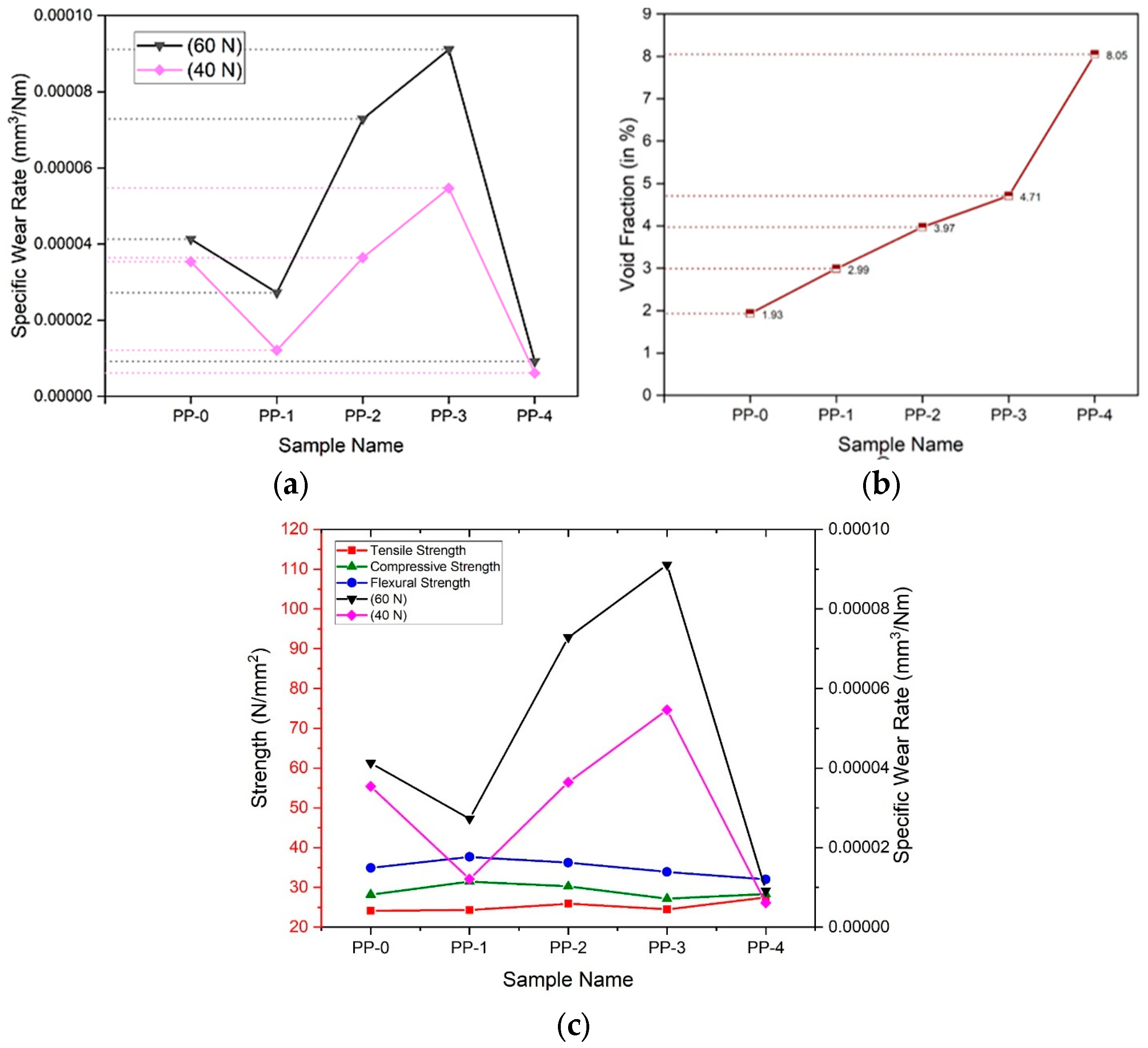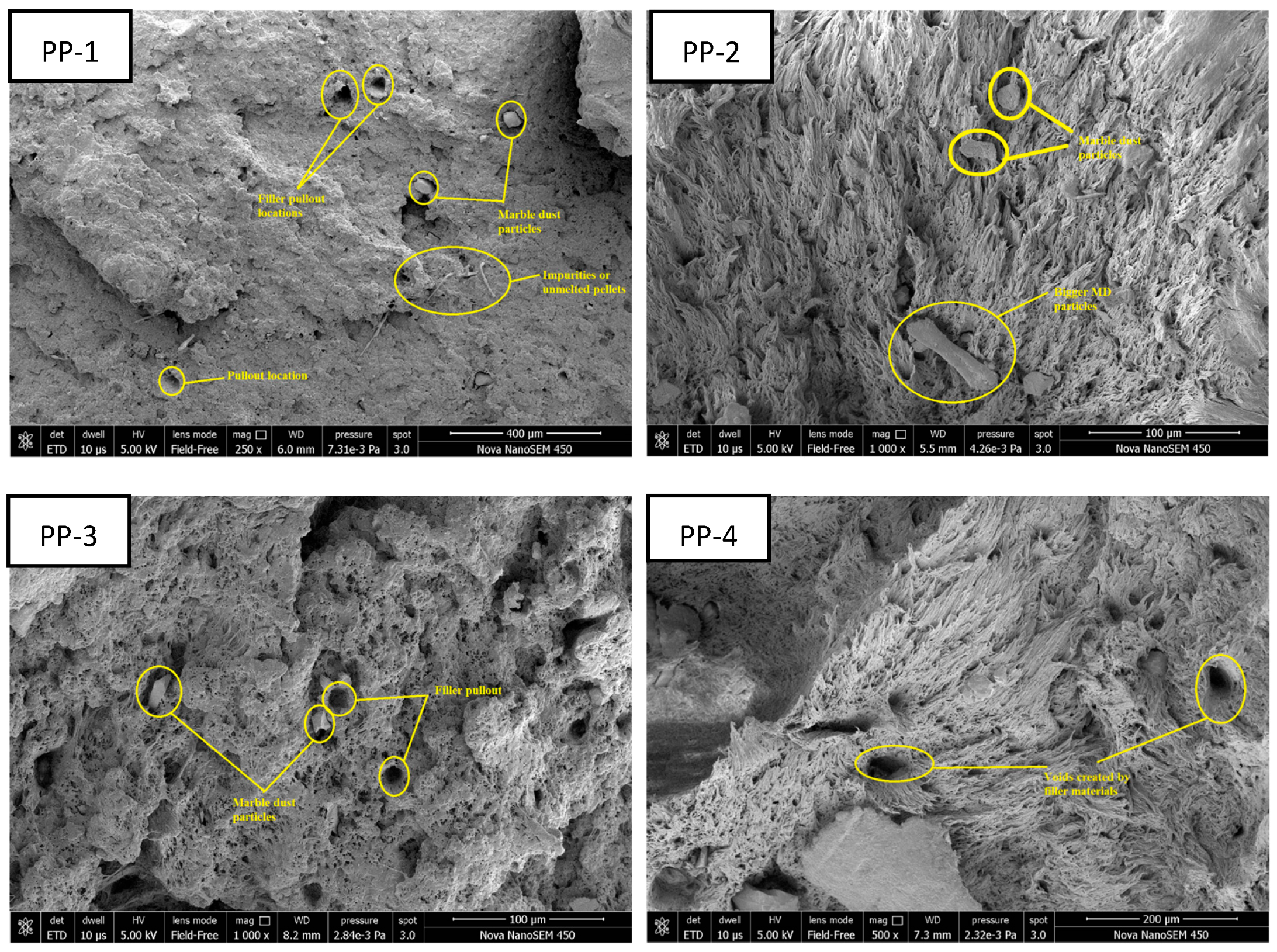Influence of Marble Dust on Mechanical and Tribological Properties of Injection Molded Polypropylene Composites †
Abstract
1. Introduction
2. Materials and Method
2.1. Materials Used
2.2. Testing Equipment and Process
2.2.1. Testing Equipment and Process for Tensile, Compression, and Flexural Testing
2.2.2. Pin-on-Disk Testing
2.2.3. Testing Equipment Used for SEM and EDS Analysis
3. Results and Discussion
3.1. Tensile, Compression, and Flexural Testing
3.2. Pin-on-Disk/Wear Rate Test and Void Fraction
3.3. SEM and EDS Analysis
4. Conclusions
Author Contributions
Funding
Institutional Review Board Statement
Informed Consent Statement
Data Availability Statement
Acknowledgments
Conflicts of Interest
References
- Akonda, M.H.; Shah, D.U.; Gong, R.H. Natural fibre thermoplastic tapes to enhance reinforcing effects in composite structures. Compos. Part A Appl. Sci. Manuf. 2020, 131, 105822. [Google Scholar] [CrossRef]
- Azammi, A.N.; Sapuan, S.M.; Ishak, M.R.; Sultan, M.T. Physical and damping properties of kenaf fibre filled natural rubber/thermoplastic polyurethane composites. Def. Technol. 2020, 16, 29–34. [Google Scholar] [CrossRef]
- Siva, R.; Valarmathi, T.N.; Venkatesh, S.; Reddy, S.S.; Pandurangan, P.; Karthikeyan, P. Mechanical characterization and microstructure analyses of nano cellulose fiber biodegradable composite. Mater. Today Proc. 2021, 44, 3673–3677. [Google Scholar] [CrossRef]
- Mohammed, A.; Batu, T.; Manaye, M.; Allasi, H.L. Free vibration characteristics of flax fiber/expanded polystyrene waste composite. Mater. Today Proc. 2021, 45, 5328–5333. [Google Scholar] [CrossRef]
- Siva, R.; Nemali, S.S.; Gokul, K. Comparison of mechanical properties and water absorption test on injection molding and extrusion-injection molding thermoplastic hemp fiber composite. Mater. Today Proc. 2021, 47, 4382–4386. [Google Scholar] [CrossRef]
- Szostak, M.; Tomaszewska, N.; Kozlowski, R. Mechanical and thermal properties of rotational molded PE/Flax and PE/Hemp composites. In Advances in Manufacturing II: Volume 4-Mechanical Engineering; Springer International Publishing: Berlin/Heidelberg, Germany, 2019; pp. 495–506. [Google Scholar]
- Chegdani, F.; Takabi, B.; El Mansori, M.; Tai, B.L.; Bukkapatnam, S.T. Effect of flax fiber orientation on machining behavior and surface finish of natural fiber reinforced polymer composites. J. Manuf. Process. 2020, 54, 337–346. [Google Scholar] [CrossRef]
- Van Vuure, A.W.; Vanderbeke, J.; Mosleh, Y.; Verpoest, I.; El-Asmar, N. Ductile woven silk fibre thermoplastic composites with quasi-isotropic strength. Compos. Part A Appl. Sci. Manuf. 2021, 147, 106442. [Google Scholar] [CrossRef]
- Christu Paul, R.; Ramachandran, B.; Sushma, G.; Harshavardhan, K.A.; Rohith, I. An empirical research on areca fiber polymer composite for automotive components in modern industry. Mater. Today Proc. 2020, 33, 4493–4497. [Google Scholar] [CrossRef]
- Punyamurthy, R.; Sampathkumar, D.; Ranganagowda, R.P.; Bennehalli, B.; Srinivasa, C.V. Mechanical properties of abaca fiber reinforced polypropylene composites: Effect of chemical treatment by benzenediazonium chloride. J. King Saud Univ. Eng. Sci. 2017, 29, 289–294. [Google Scholar] [CrossRef]
- Bledzki, A.K.; Jaszkiewicz, A.; Scherzer, D. Mechanical properties of PLA composites with man-made cellulose and abaca fibres. Compos. Part A Appl. Sci. Manuf. 2009, 40, 404–412. [Google Scholar] [CrossRef]
- Pappu, A.; Pickering, K.L.; Thakur, V.K. Manufacturing and characterization of sustainable hybrid composites using sisal and hemp fibres as reinforcement of poly (lactic acid) via injection moulding. Ind. Crops Prod. 2019, 137, 260–269. [Google Scholar] [CrossRef]
- Meena, R.; Mali, H.S.; Meena, A.; Sharma, P.N.; Kumar, P.; Choudhary, K. Influence of alumina powder (Al2O3) on mechanical and tribological properties of injection molded polyoxymethylene composites. Mater. Today Proc. 2023, in press. [CrossRef]
- Meena, R.; Hashmi, A.W.; Ahmad, S.; Iqbal, F.; Soni, H.; Meena, A.; Al-Kahtani, A.A.; Pandit, B.; Kamyab, H.; Payal, H.; et al. Influence of fly ash on thermo-mechanical and mechanical behavior of injection molded polypropylene matrix composites. Chemosphere 2023, 343, 140225. [Google Scholar] [CrossRef] [PubMed]





| S. No. | Sample Name | Specific Wear Rate at 40 N Load (mm3/Nm) (×10−5) | Specific Wear Rate at 60 N Load (mm3/Nm) (×10−5) | Void Fraction (%) |
|---|---|---|---|---|
| 1 | PP-0 | 3.53 | 4.12 | 1.93 |
| 2 | PP-1 | 1.21 | 2.72 | 2.99 |
| 3 | PP-2 | 3.64 | 7.28 | 3.97 |
| 4 | PP-3 | 5.46 | 9.1 | 4.71 |
| 5 | PP-4 | 0.61 | 0.91 | 8.05 |
Disclaimer/Publisher’s Note: The statements, opinions and data contained in all publications are solely those of the individual author(s) and contributor(s) and not of MDPI and/or the editor(s). MDPI and/or the editor(s) disclaim responsibility for any injury to people or property resulting from any ideas, methods, instructions or products referred to in the content. |
© 2025 by the authors. Licensee MDPI, Basel, Switzerland. This article is an open access article distributed under the terms and conditions of the Creative Commons Attribution (CC BY) license (https://creativecommons.org/licenses/by/4.0/).
Share and Cite
Meena, R.; Hashmi, A.W.; Ahmad, S.; Iqbal, F.; Meena, A.; Yusuf, M.; Ibrahim, H. Influence of Marble Dust on Mechanical and Tribological Properties of Injection Molded Polypropylene Composites. Eng. Proc. 2024, 76, 110. https://doi.org/10.3390/engproc2024076110
Meena R, Hashmi AW, Ahmad S, Iqbal F, Meena A, Yusuf M, Ibrahim H. Influence of Marble Dust on Mechanical and Tribological Properties of Injection Molded Polypropylene Composites. Engineering Proceedings. 2024; 76(1):110. https://doi.org/10.3390/engproc2024076110
Chicago/Turabian StyleMeena, Rajhans, Abdul Wahab Hashmi, Shadab Ahmad, Faiz Iqbal, Anoj Meena, Mohammad Yusuf, and Hussameldin Ibrahim. 2024. "Influence of Marble Dust on Mechanical and Tribological Properties of Injection Molded Polypropylene Composites" Engineering Proceedings 76, no. 1: 110. https://doi.org/10.3390/engproc2024076110
APA StyleMeena, R., Hashmi, A. W., Ahmad, S., Iqbal, F., Meena, A., Yusuf, M., & Ibrahim, H. (2024). Influence of Marble Dust on Mechanical and Tribological Properties of Injection Molded Polypropylene Composites. Engineering Proceedings, 76(1), 110. https://doi.org/10.3390/engproc2024076110







